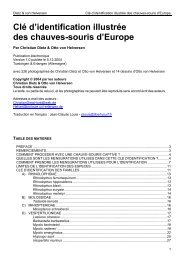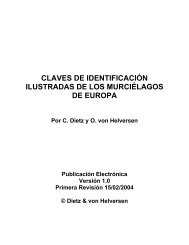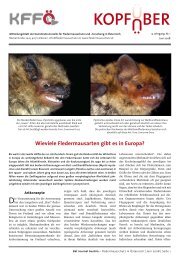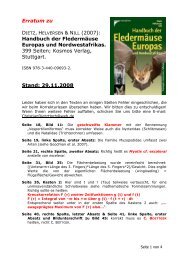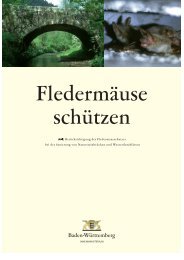Dietz & von Helversen Illustrated Identification key to the bats of ...
Dietz & von Helversen Illustrated Identification key to the bats of ...
Dietz & von Helversen Illustrated Identification key to the bats of ...
Create successful ePaper yourself
Turn your PDF publications into a flip-book with our unique Google optimized e-Paper software.
<strong>Dietz</strong> & <strong>von</strong> <strong>Helversen</strong><strong>Illustrated</strong> <strong>Identification</strong> <strong>key</strong> <strong>to</strong> <strong>the</strong> <strong>bats</strong> <strong>of</strong> EuropeV) Genus Eptesicus (Eptesicus serotinus – Eptesicus nilssonii – Eptesicusbottae)The two widely distributed species E. serotinus and E. nilssonii can be separated byexternal measurements only. In Europe E. bottae occurs only on some <strong>of</strong> <strong>the</strong> Greekislands <strong>of</strong>f <strong>the</strong> Ana<strong>to</strong>lian coast.►►► large and robust species, FA: 48.0 – 58.0 mm, D5 > 60 mm (59 – 69 mm allover Europe, 61 – 67 mm in sou<strong>the</strong>rn Greece and <strong>the</strong> Greek islands), D3: 84 – 92mm. The muzzle is wide and robust (Fig. 199). The tragus is broad and <strong>the</strong> ears arelong (Fig. 200). The penis is only slightly widened <strong>to</strong>wards <strong>the</strong> end and its upper sidehas a weak medial ridge (Fig. 201). Pelage on <strong>the</strong> back ranging in colour from darkbrown <strong>to</strong> sometimes yellowish or golden brown (Fig. 199). Dark black ears andmuzzle. – Eptesicus serotinusAdditional characters: In south-eastern Europe, especially on <strong>the</strong> Greek islands, <strong>the</strong>dorsal pelage is a light yellowish brown. Hair on <strong>the</strong> back long (about 11 mm).Distribution in Europe: Ranging all over Europe, in <strong>the</strong> north <strong>to</strong> central Britain, <strong>the</strong>sou<strong>the</strong>rnmost Sweden and <strong>the</strong> Baltic states. Absent from Ireland and perhaps also fromSardinia.Taxonomical note: A small serotine has been described as a species on its own fromRomania: Eptesicus sodalis and has been subsequently found in various parts <strong>of</strong> Europe.The form sodalis is believed now <strong>to</strong> be a synonym <strong>of</strong> Eptesicus serotinus, as <strong>the</strong>se <strong>bats</strong>seem <strong>to</strong> be just unusual small individuals.Pho<strong>to</strong>graphs: 55 and 100 – 102 and 199 – 201.►► smaller species, FA: 37.0 – 44.0 mm, D5: 45 – 56 mm, D3: 62 - 68 mm. Dorsalpelage dark brown <strong>to</strong> black with light golden tips on <strong>the</strong> back and <strong>the</strong> forehead (Fig.196). A well defined line <strong>of</strong> demarcation along <strong>the</strong> sides <strong>of</strong> <strong>the</strong> neck <strong>to</strong>wards <strong>the</strong> lightyellowish brown underparts. – Eptesicus nilssonii57



